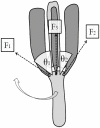Tri-axial dynamic acceleration as a proxy for animal energy expenditure; should we be summing values or calculating the vector?
- PMID: 22363576
- PMCID: PMC3281952
- DOI: 10.1371/journal.pone.0031187
Tri-axial dynamic acceleration as a proxy for animal energy expenditure; should we be summing values or calculating the vector?
Abstract
Dynamic body acceleration (DBA) has been used as a proxy for energy expenditure in logger-equipped animals, with researchers summing the acceleration (overall dynamic body acceleration--ODBA) from the three orthogonal axes of devices. The vector of the dynamic body acceleration (VeDBA) may be a better proxy so this study compared ODBA and VeDBA as proxies for rate of oxygen consumption using humans and 6 other species. Twenty-one humans on a treadmill ran at different speeds while equipped with two loggers, one in a straight orientation and the other skewed, while rate of oxygen consumption (VO2) was recorded. Similar data were obtained from animals but using only one (straight) logger. In humans, both ODBA and VeDBA were good proxies for VO2 with all r(2) values exceeding 0.88, although ODBA accounted for slightly but significantly more of the variation in VO2 than did VeDBA (P<0.03). There were no significant differences between ODBA and VeDBA in terms of the change in VO2 estimated by the acceleration data in a simulated situation of the logger being mounted straight but then becoming skewed (P = 0.744). In the animal study, ODBA and VeDBA were again good proxies for VO2 with all r(2) values exceeding 0.70 although, again, ODBA accounted for slightly, but significantly, more of the variation in VO2 than did VeDBA (P<0.03). The simultaneous contraction of muscles, inserted variously for limb stability, may produce muscle oxygen use that at least partially equates with summing components to derive DBA. Thus, a vectorial summation to derive DBA cannot be assumed to be the more 'correct' calculation. However, although within the limitations of our simple study, ODBA appears a marginally better proxy for VO2. In the unusual situation where researchers are unable to guarantee at least reasonably consistent device orientation, they should use VeDBA as a proxy for VO2.
Conflict of interest statement
Figures







References
-
- Bartumeus F, Catalan J. Optimal search behavior and classic foraging theory. Journal of Physics a-Mathematical and Theoretical. 2009;42
-
- Pyke GH. Optimal Foraging Theory: A Critical Review. Annual Review of Ecology and Systematics. 1984;15:523–575.
-
- Murray MG. Maximizing Energy Retention in Grazing Ruminants. Journal of Animal Ecology. 1991;60:1029–1045.
-
- Bergman CM, Fryxell JM, Gates CC, Fortin D. Ungulate foraging strategies: energy maximizing or time minimizing? Journal of Animal Ecology. 2001;70:289–300.
-
- Shipley LA. The influence of bite size on foraging at larger spatial and temporal scales by mammalian herbivores. Oikos. 2007;116:1964–1974.
Publication types
MeSH terms
LinkOut - more resources
Full Text Sources
Other Literature Sources
Miscellaneous

